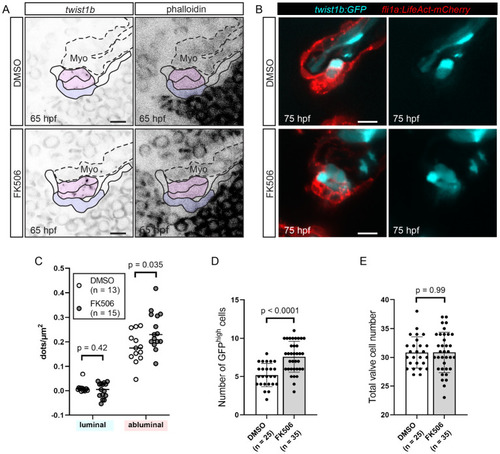Fig 12
|
FK506-treated embryos have increased twist1b expression at 65 hpf.
(A, C) Wild-type embryos were treated with DMSO or FK506 from 60 hpf, fixed at 65 hpf, and twist1b RNAscope was performed. (A) Representative images of developing superior AV valves at 65 hpf that have been stained using the twist1b probe in DMSO-treated controls (top row) and FK506-treated embryos (bottom row). Our interpretation of valve morphology superimposed on the images and blue (luminal) and magenta (abluminal) regions are used for quantifications in (C). (B, D, E) Tg(twist:GFP);Tg(fli1a:Lifeact-mCherry) embryos were treated with DMSO or FK506 from 60 hpf to 75 hpf. (B) Example images of DMSO-treated and FK506-treated embryos in the Tg(twist:GFP);Tg(fli1a:Lifeact-mCherry) background. (C) Dot plots showing the number of detected dots, each corresponding to 1 twist1b mRNA molecule in luminal and abluminal valve regions (shaded in purple and pink, respectively, in (A)). Statistical significance was calculated using Student t test. (D) Graph showing the number of cells with bright GFP signal (GFPhigh cells) in Tg(twist:GFP);Tg(fli1a:Lifeact-mCherry) embryos treated with DMSO or FK506. Statistical significance was determined using Student t test. (E) Total valve cell number in the same embryos used for quantification in (D). Statistical significance was determined using Student t test. Scale bars: 10 ?m. AV, atrioventricular valve; hpf, hours postfertilization; Myo, myocardium. |

